
Platanus × acerifolia, Platanus × hispanica, or hybrid plane, is a tree in the genus Platanus. It is often known by the synonym London plane, or London planetree. It is usually thought to be a hybrid of Platanus orientalis and Platanus occidentalis. Some authorities think that it may be a cultivar of P. orientalis.

Platanus occidentalis, also known as American sycamore, American planetree, western plane, occidental plane, buttonwood, and water beech, is a species of Platanus native to the eastern and central United States, the mountains of northeastern Mexico, extreme southern Ontario, and possibly extreme southern Quebec. It is usually called sycamore in North America, a name which can refer to other types of trees in other parts of the world. The American sycamore is a long-lived species, typically surviving at least 200 years and likely as long as 500–600 years.
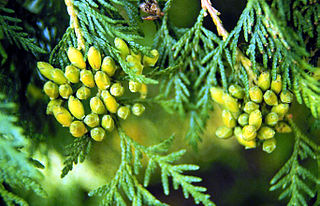
Thuja occidentalis, also known as northern white-cedar, eastern white-cedar, or arborvitae, is an evergreen coniferous tree, in the cypress family Cupressaceae, which is native to eastern Canada and much of the north-central and northeastern United States. It is widely cultivated as an ornamental plant.

Rubus occidentalis is a species of Rubus native to eastern North America. Its common name black raspberry is shared with other closely related species. Other names occasionally used include bear's eye blackberry, black cap, black cap raspberry, and scotch cap.
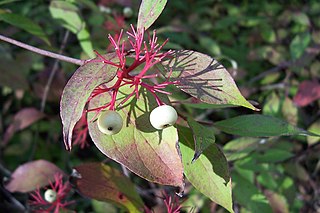
Cornus sericea, the red osier or red-osier dogwood, is a species of flowering plant in the family Cornaceae, native to much of North America. It has sometimes been considered a synonym of the Asian species Cornus alba. Other names include red brush, red willow, redstem dogwood, redtwig dogwood, red-rood, American dogwood, creek dogwood, and western dogwood.

Cephalanthus occidentalis is a species of flowering plant in the family Rubiaceae that is native to eastern and southern North America. Common names include buttonbush, common buttonbush, button-willow, buck brush, and honey-bells.

Celtis laevigata is a medium-sized tree native to North America. Common names include sugarberry, Southern hackberry, or in the southern U.S. sugar hackberry or just hackberry.
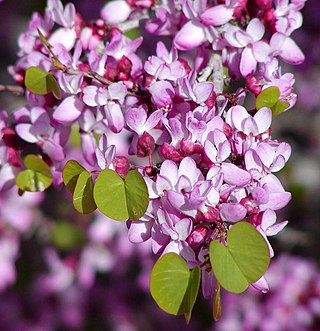
Cercis occidentalis, the western redbud or California redbud, is a small tree or shrub in the legume family, Fabaceae. It is found across the American Southwest, from California to Utah and Arizona.

Ranunculus glaberrimus, the sagebrush buttercup, is a species of flowering plant in the buttercup family, Ranunculaceae. It is native to interior western North America, in western Canada, the western United States, and the northwestern Great Plains.

Turpinia is a genus of trees and shrubs in family Staphyleaceae, native to Asia and North, Central, and South America. Species include:
Muttonwood is a common name for several plants and may refer to:
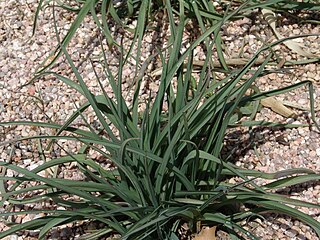
Tradescantia occidentalis, the prairie spiderwort or western spiderwort, is a plant in the dayflower family, Commelinaceae. It is common and widespread across the western Great Plains of the United States, as well as in Arizona, New Mexico, southern Utah, and Sonora, but is listed as a threatened species in Canada.

Osmorhiza occidentalis is a species of flowering plant in the family Apiaceae known by the common name western sweet cicely or western sweetroot.

Senna occidentalis [Indian vernacular name Usaya ki Fali] is a pantropical plant species, native to the Americas. The species was formerly placed in the genus Cassia.
Actaea arizonica is a species of flowering plant in the buttercup family known by the common name Arizona bugbane. It is endemic to Arizona in the United States, where it occurs in Coconino, Gila, and Yavapai Counties. Like some other species in genus Actaea, this plant was formerly included in the genus Cimicifuga.

Primula austrofrigida, syn. Dodecatheon austrofrigidum, is a species of flowering plant in the primrose family known by the common names frigid shooting star and tundra shooting star. It is native to Washington and Oregon in the United States, where it grows in the coastal mountain ranges, including those on the Olympic Peninsula.
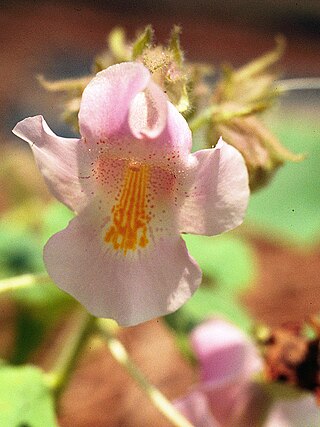
Proboscidea louisianica is a species of flowering plant in the family Martyniaceae. Its true native range is unclear, but probably includes parts of the southwestern United States and Mexico in North America. It occurs in other areas, including other regions in North America, Europe, Australia, and South Africa, as an introduced species. It is the most widely distributed species in its family. Common names it shares with other Proboscidea species include devil's claw and unicorn-plant. Names more specific to the species include common devil's claw, ram's horn, aphid trap, Louisiana unicorn-plant, purple-flowered devil's-claw, goat's head, and elephant tusks.
Prunus occidentalis is a plant in the family Rosaceae of the order Rosales.
Lipocarpha occidentalis, the Western halfchaff sedge, or Pacific halfchaff sedge, is a plant species native to western part of the United States but cultivated as an ornamental in other regions. It is widespread in California, with populations also reported from Oregon and Washington state.
T. occidentalis may refer to several different species. The specific epithet occidentalis means 'western.'















